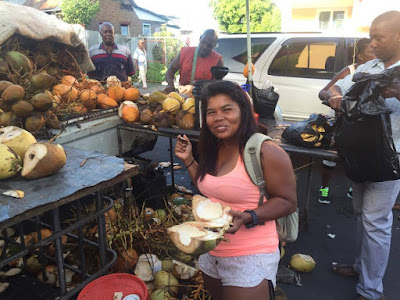It seems to me that the coconut palm has to be one of the most successful plants on Earth. Wherever the plant first evolved, it has since spread to all points of the tropics. The way it must have accomplised that -- by drifting across large expanses of ocean, is equally intriguing (at least to me). Come to think of it, coconuts are master voyagers. Maybe that's part of their appeal for me.
While I should have been doing something more productive, I started to google the origin of the coconut and found some interesting things I'd like to share.
First, the coconut is no nut. It is something scientists call a "drupe." Here's an explanation from Coconut-info.net:
"A drupe consists of three layers: the exocarp, mesocarp (which represents the husk of the fruit), and endocarp. The mesocarp contains coir - a seed fiber ... [used] for example, to produce brushes, ropes, fishnets etc. The shell contains one single seed."When the coconut flesh is dried, it is known as copra.
"Spanish explorers named the cocos -- meaning 'grinning face,' because of the three little eyes on the base which they thought resembled a monkey," according to the BBC.
There are two different distinct forms of "nut" known by their Samoan names -- niu kafa and niu vai. Niu kafa is triangular in shape, oblong and has a large fibrous husk, according to evolutionary plant biologist Kenneth Olsen of Washington University in St. Louis. Niu vai is more rounded and contains sweet coconut water before it ripens. A third variety of dwarf coconuts accounts for only about 5 percent of the plants and appears to be the result of human domestication.
The nui vai variety are brightly colored and either green, yellow or reddish gold. The trees themselves are categorized by their relative size. Smaller palms produce most of the coconuts for immediate consumption.

Where did the plant originate? No one knows for sure. There are two main hypotheses -- that it originated in peninsular Southeast Asia and the other that it came from northwestern South America.
As Florida-coconuts.com notes, in Hawaii, "the coconut is not considered a native fruit, because it was originally brought to the islands long ago by Polynesian travelers from the South Pacific." Discounting the largely discredited Thor Heyerdahl theory of an east-to-west settlement of the Pacific, it would seem to me that this fact alone favors the Southeast Asia hypothesis.
In fact, DNA analysis conducted by Olsen concluded that there are "two clearly differentiated populations of coconuts, a finding that strongly suggests the coconut was brought under cultivation in two separate locations, one in the Pacific basin and the other in the Indian Ocean basin." No mention of South America.
There's a lot written about the health benefits of coconuts, but a lot of it is on poorly sourced and "alternative" websites that are not verified. What does seem certain is this: coconuts are rich in fiber and contain vitamins C, E, B1, B3, B5 and B6 as well as minerals including iron, selenium, sodium, calcium, magnesium and phosphorous. And coconut milk is, of course, lactose free. It's also a natural laxative, so drinking too much might not be wise.
Oh, and something I've wondered about for years: an estimated 150 people a year are thought to die from falling coconuts!



Hello my friend Noi how are you doing dear friend longtime I don't hear you I m Erns from île à vache did you remember me my friend!
ReplyDelete